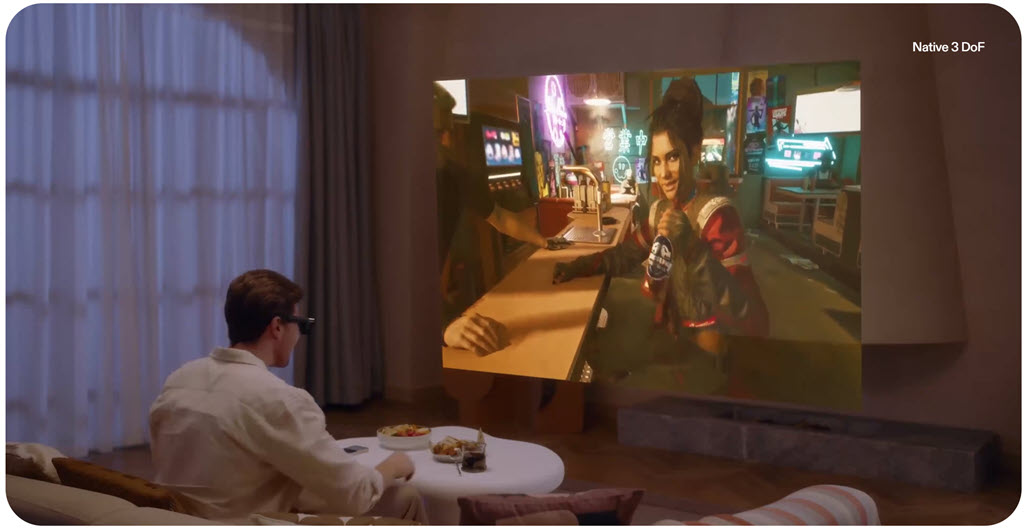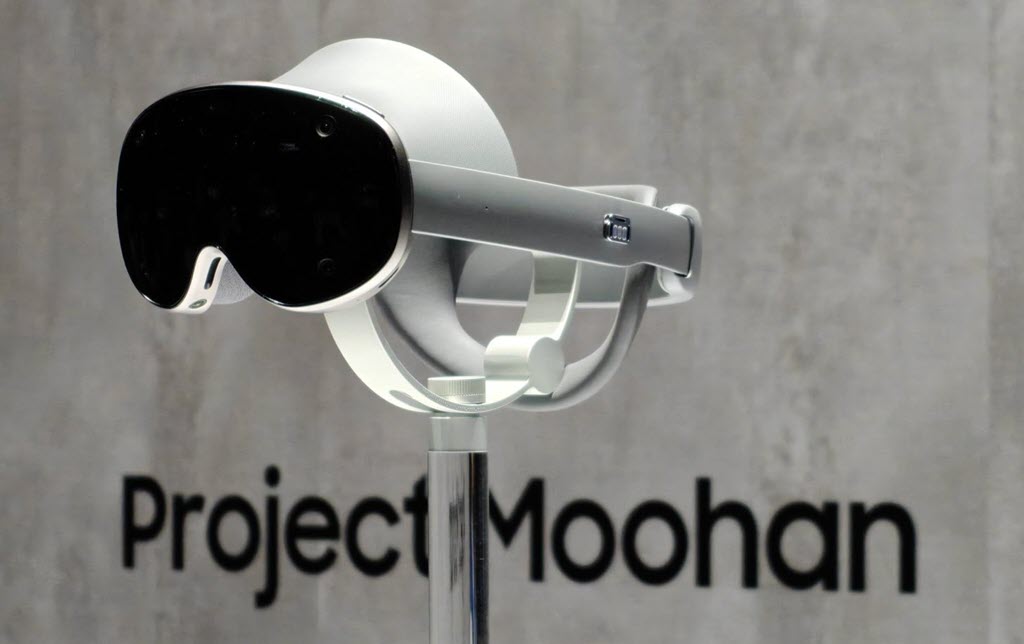
I’m watching Love Death + Robots on a 191” screen hanging in the air four feet in front of me. That’s about the same size as an IMAX screen when you’re sitting in the middle of the theater and the scene fills your field of view and you have to look slightly left or right to see the edges.
I’m not sitting in a recliner. That’s too much work. I’m lying on my couch and the screen is overhead at just the right angle to permit maximal laziness.
I can do this with my Quest 3 VR helmet and be completely immersed. But today I’m trying to lower the nerd quotient in case my wife walks in, so I’m wearing Xreal One Pro glasses, which appear to be slightly bulky sunglasses. Xreal One Pro glasses are the state of the art in mid-June 2025 – Xreal just started shipping pre-orders from China, and they’ll probably be available on Amazon in the next few weeks.
If you’ve been reading my articles for a while, you know that the state of the art for AR glasses is constantly changing and definitions shift around, so this latest iteration of the Xreal glasses is a stepping stone, nothing more. But they’re pretty great, a giant leap forward in their category, so let’s pause for a snapshot of where things stand this summer.
There’s no agreement about what to call the Xreal One glasses and their competitors from Rokid and Viture: smart glasses, AR (“augmented reality”), XR (“extended reality”), MR (“mixed reality”), terms that are used interchangeably because tech companies hate us.
It’s worse than you think because there are other glasses similar in appearance that offer completely different experiences – literally no overlap but easily confused because all of them are called “smart glasses.”
So let’s start with a rough breakdown of the categories of high tech glasses and headsets in 2025: portable monitors; AI assistants; and VR headsets.
PORTABLE MONITORS

Xreal One Pro glasses are portable monitors, a display hanging in front of your face. They use a clever system of lenses and mirrors to show a bright, crystal clear picture in the air. It appears to be huge because the images are really close to your eyes – but it’s also crisp with 1080p resolution, sharp enough to read text easily. People are using them for productivity.
The glasses don’t do anything by themselves; the display comes through a cable running to the left stem of the Xreal One glasses from another device – phone, laptop, computer, or game deck.
The feature that sets the Xreal One Pro glasses apart, the next generation technology, is a processor in the frame that holds the display in place when I move my head, like a TV mounted on the wall. It’s called “3DoF”, “3 degrees of freedom,” and that sounds simple and obvious, right? It is obvious but it’s not at all simple and Xreal is the first company able to build it into the glasses. The displays on all the other glasses move around as your head moves. (There are all kinds of asterisks to that but that’s close enough to get you oriented.)
The Xreal One glasses work brilliantly with my iPad Mini – a match made in heaven for watching movies on a plane. The audio is rich and clear with relatively little spilling over to the people around you. Netflix looks gorgeous regardless of whether the glasses are connected to my Google Pixel 9 Pro phone or my Macbook Air. Reportedly the glasses provide a beautiful display for playing games on a Steam Deck or Nintendo Switch. Xreal sells a standalone separate device, the “Beam Pro,” for running apps and games as an alternative to a phone/tablet/computer.
The Xreal One glasses are slightly bigger and thicker than regular sunglasses. They sit higher on the face than conventional glasses and the little mirrored displays are visible through the regular lenses. If you saw someone wearing them on an airplane, you’d give them a second glance but only because dark glasses on a plane are weird. On that closer look, you’d know they aren’t normal glasses but you wouldn’t recoil from the nerd vibes. I’ll tell you more about the details below.
AI GLASSES
Compare the Xreal One Pro to the Meta Ray-Ban glasses, which also look like sunglasses – literally, they’re just Ray-Ban sunglass frames packed with electronics. Last week Meta announced new models coming from Oakley.
Meta’s glasses do not have any display at all. They do tricks with AI through a bluetooth connection to a nearby phone. You can ask questions and get AI answers, and use the built-in camera to get AI-based info about the world around you. AI is stepping into so many roles that there are no limits to what you might use the glasses to do. The most obvious is live real-time translation, a holy grail for AI that is tantalizingly close.
The Meta Ray-bans are aggressively low-priced, barely more than regular Ray-bans, and they’ve been selling like gangbusters. Google is jealous, so it just unveiled plans for Android XR, a new operating system for headsets and glasses.
Google was badly burned by the negative reaction to Google Glass, so this time it’s going to let other manufacturers create the actual products. Samsung and others will try to match Meta’s fashion forward approach by putting Android XR in frames by Warby Parker and other eyeglass designer companies. The Android XR glasses will connect to Google Gemini, which today is far ahead of Meta AI.
But Google is also hoping to add a visual element. See the map in the above picture? There’s a tiny display on the lenses to show, say, walking directions or business information without interfering with wearing the glasses outside. A great concept, a journalist got a demo, but there are questions, many many questions.
Xreal was also onstage with Google last month for the Android XR announcement, promising that its next generation of products will have a display like the Xreal One glasses – the monitor-in-the-air part – but also a connection to Google Gemini AI. It’s a big promise, because that means a new chipset, new operating system, more parts packed into small spaces. Xreal is a relatively small privately held Chinese company but credit where credit is due, it stepped ahead of the competitors this month. Maybe it can pull the next rabbit from the smart glasses hat.
VR HEADSETS

Google’s other partner for Android XR is Samsung, which plans to release VR headsets running Android XR later this year (likely on September 29).
Samsung is a big manufacturer but the announcement of “Project Moohan” was underwhelming. The prototype looks like a cross between ski goggles and a swim mask. Google’s combination of Gemini AI and Android apps might be appealing, but the device itself looks quaintly retro after living with Meta Quest VR headsets for several years and after Apple’s splashy introduction of the Vision Pro last year.
VR headsets are an entirely separate category than the smart glasses described above. Let’s not mince words:
The Meta Quest 3 offers a better experience – better visuals, better audio, more immersive, standalone – than the Xreal glasses or their competitors, at a lower price.
But using the Quest 3 means putting on a headset and having an isolated experience, and a lot of people have trouble with that concept. And you’ll look like the kind of geek that people shun (and you’ll use up too much carry-on space) if you bring the Quest 3 onto an airplane. And the possible nausea, don’t forget the nausea. The Quest 3 is the most exciting new device I’ve gotten in the last ten years but it’s not for everyone.
A FEW TECH DETAILS
You can buy Meta Ray-Ban AI glasses and talk to an AI assistant with no fuss and a minimal learning curve.
It’s different with the Xreal One Pro glasses or the others like them. Strapping a monitor to your head requires far more planning.
MODELS Xreal makes two models, the Xreal One and Xreal One Pro. I think the upgrade to the Pro model is worth $100 ($150 after June 30) – brighter display, wider field of view, thinner profile. But I think a lot of things. Your money, your choice.
IPD The displays will be blurry at the edges if they do not match your IPD. You don’t know what that is but you’ll need to figure it out – and measure it – before you order the Xreals. It’s the distance between your pupils. My head apparently has the same proportions as Charlie Brown, so a selling point of the Xreal One Pro was availability of a “Large” size for my 70 IPD.
PRESCRIPTION LENSES You can’t wear glasses under the Xreal One Pro. If you wear prescription glasses, be prepared for another $49 to order prescription lenses from HonsVR that attach to the Xreals.
BATTERY The Xreals draw power from the device they’re attached to. They’ll run the battery down on your iPad or phone. Complaining about battery life is a full-time occupation for armies of people online and maybe the Xreal battery draw will make you furious too. Then you’ll shell out another $39 for a hub that charges the phone while you watch, if you don’t mind that you look like an idiot because you have cables running in every direction. I do it because hey, monitor in the air, cool, personal pride and self-esteem be damned.
REDDIT If you’re interested in the Xreal glasses, you can read reviews with all the specs like this one (“the best AR smart glasses I’ve tested in four years of reviewing XR tech”). At some point in your googling, you’ll find yourself in the r/Xreal community on Reddit, hip deep in the typical Reddit swamp of useful tips, complaints, misinformation, ad hominem attacks, aggressive pedantry, misunderstandings based on lack of tone, nostalgia, complaints, unrelated personal anecdotes, highly specific niche grievances, a few more useful tips, and complaints.
Be prepared.
For some of you – the tech elite, the early adopters, the people with enough money to take chances, future-seekers, or anyone prone to FOMO – the 3DoF screen fixed in front of you with the Xreal One Pro glasses is new and exciting. For a few months you can be the talk of the neighborhood, possibly in a good way. They’ll be the state of the art for easily another 30 days – why not dive in?

